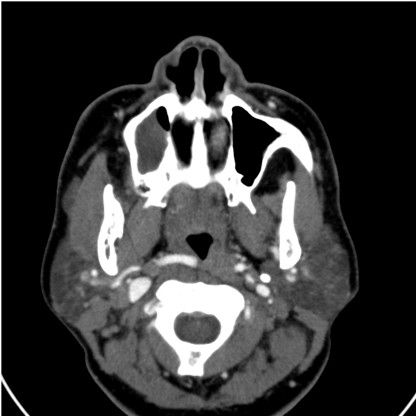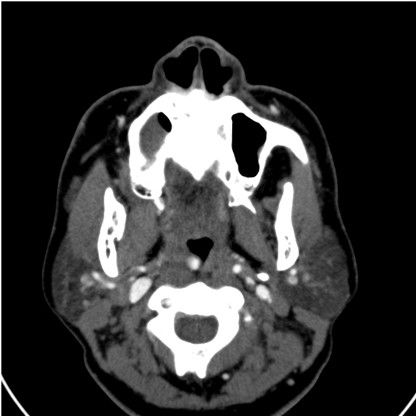Aberrant ICA
A 57-year-old female presents to the emergency department with dysphagia and reports her throat is “closing up.” On physical exam, there are no palpable masses appreciated along the neck, and the thyroid descends along the midline on swallowing and is noted to be slightly enlarged.
Clinical History
A 57-year-old female presents to the emergency department with dysphagia and reports her throat is “closing up.” Recently, within the last three to four days, the dysphagia has progressed to the point of being unable to eat solid foods. On physical exam, there are no palpable masses appreciated along the neck, and the thyroid descends along the midline on swallowing and is noted to be slightly enlarged.
Findings
Contrast enhanced axial images of the neck soft tissues (Figures A, B) denote an unusual medial course of the Right Internal Carotid Artery. Figure B denotes the Right ICA just deep to the pharyngeal mucosa within the posterior oropharynx.
Figure A

Figure B

Diagnosis
Midline Variation in the Course Right Internal Carotid Artery
Discussion
Variations of the Internal Carotid Artery have been examined in several studies over the last 50 years. Of primary interest to the ENT and vascular specialties, the course of the ICA can have dramatic and potentially lethal consequences during otherwise low-risk procedures such as tonsillectomy or adenoidectomy.
In review of several large case series in which over 4,000 carotid angiograms were examined, variations from the typical straight course were seen in 4 percent to 66 percent of adults and 16 percent to 43 percent of children, with the majority of these abnormalities occurring bilaterally.1 In a recent study which looks at the prevalence of these variations among adults, the most common variation found is a lateral curvature of the ICA (13 percent), followed closely by medial curvature (10 percent).2 Kinking of the ICA is seen in 2.2 percent, with half of those variations in close proximity to the pharyngeal wall. Coil or loop formations of the ICA are seen in 1.7 percent of cases, with half of the formations in close proximity to the pharyngeal wall as well.2
While curvature of the ICA has been attributed to part of the normal aging process and does not seem directly related to either a pathologic or congenital cause, kinking of the ICA has been associated with atherosclerotic change and or fibromuscular dysplasia. Over time, the vessel becomes tortuous as sequential plaque formation, vessel stenosis, and distal dilation distort what may have been a gentle curve or even a straight course into a sharply angled switchback. Given these associations, patients with kinking of the ICA are at an increased risk for cerebrovascular injury.2
As kinking of the ICA may be seen as the dangerous variant for the elderly, the loop formation considered to be a congenital defect may be thought of as the variant of interest in the young. The loop formation is thought to be derived from a congenital lack of regression of one or more of the branchial arch vessels, predominantly the 3rd arch. These vessels do not appear to increase the risk of atherosclerotic plaque formation, and are usually asymptomatic. The formation has been called the “dangerous loop,” however, due to the high probability that formation will be in close association with the pharyngeal wall.
These dangerous and rare variants of the ICA may be encountered as a symptomatic mass, or as part of an unrelated surgical procedure, such as a biopsy or tonsillectomy. ENT and vascular surgeons should be reminded of the importance of evaluating for this potentially lethal variant. Episodes of dysphagia may be the only symptom in a patient with a dangerous variant of the vessel. Given the risk of serious complication in both young and old, investigation with duplex ultrasound or CT of the neck should be performed in order to assess the course of the ICA prior to any surgical procedure involving the pharyngeal space. In the event that a patient has a pulsatile mass along the neck that is not observed to be related to the ICA by CT angiography, Magnetic Resonance Angiography may prove to be more beneficial.3
Treatment of patients with symptomatic tortuous internal carotid arteries include: endarterectomy, covered stenting, or vessel grafting, depending on the severity of the atherosclerotic change.4 Given previously stated increased risk for CVA, clinicians should be vigilant for neurologic sequelae following vascular procedures in this patient population. TIA has been shown to be the most common neurologic complication post-procedure; however, permanent neurologic deficit may occur in rare cases.
Submitted by David Hunte, MS-IV, (School of Medicine) and Richard Desruisseau, MD, Department of Radiology at Meharry Medical College, Nashville, Tenn.
1. Desai B & Toole J. Kinks Coils and Carotids: A Review. Stroke. 1975; 6:649-653
2. Paulsen P. Curving and looping of the internal carotid artery in relation to the pharynx: frequency, embryology and clinical implications. Journal of Anatomy Royal Society of Medicine; 2000; 197: 373-381
3. Windfuhr J. A devastating outcome after adenoidectomy and tonsillectomy: Ideas for improved prevention and management. Otolaryngology Head and Neck Surgery. 2009; 140: 191-1973.
4. Radonic V. Surgical treatment of kinked internal carotid artery. Journal of Cardiovascular Surgery (Torino).1998 Oct; 39(5):557-63.
Emerging AI Algorithm Shows Promise for Abbreviated Breast MRI in Multicenter Study
April 25th 2025An artificial intelligence algorithm for dynamic contrast-enhanced breast MRI offered a 93.9 percent AUC for breast cancer detection, and a 92.3 percent sensitivity in BI-RADS 3 cases, according to new research presented at the Society for Breast Imaging (SBI) conference.
Could AI-Powered Abbreviated MRI Reinvent Detection for Structural Abnormalities of the Knee?
April 24th 2025Employing deep learning image reconstruction, parallel imaging and multi-slice acceleration in a sub-five-minute 3T knee MRI, researchers noted 100 percent sensitivity and 99 percent specificity for anterior cruciate ligament (ACL) tears.
New bpMRI Study Suggests AI Offers Comparable Results to Radiologists for PCa Detection
April 15th 2025Demonstrating no significant difference with radiologist detection of clinically significant prostate cancer (csPCa), a biparametric MRI-based AI model provided an 88.4 percent sensitivity rate in a recent study.